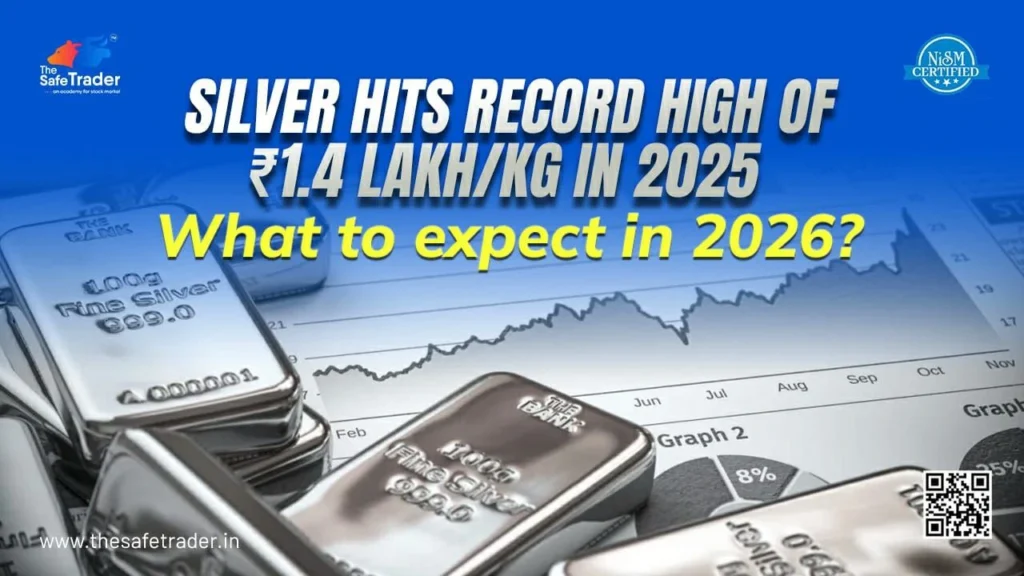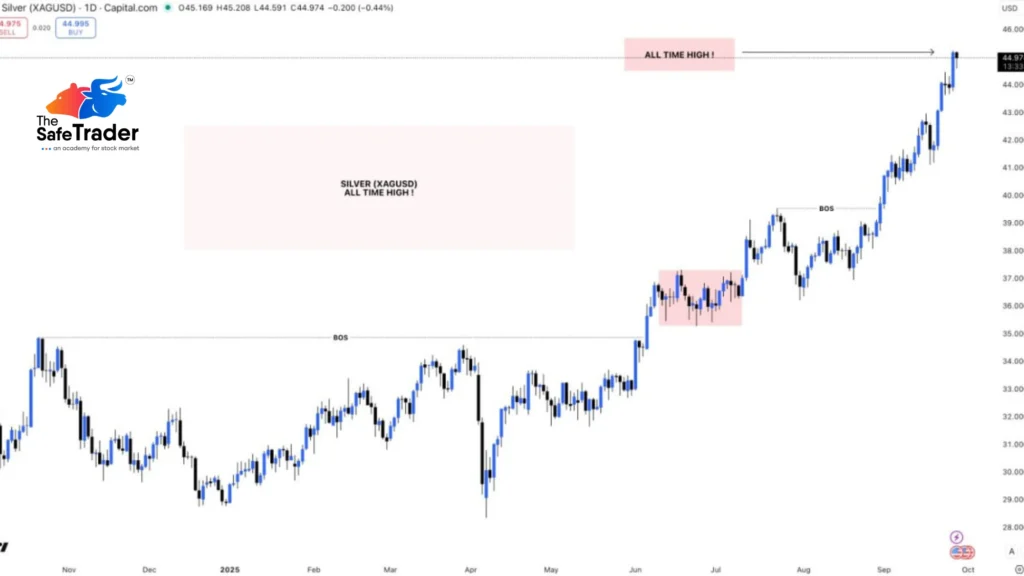
Silver Tops Record in 2025
This year, silver-often referred to as the “poor man’s gold”- has gained attention in the Indian market. In the domestic market, silver prices hit a record high of ₹1.4 lakh per kilogram on Thursday, representing a startling 59% increase so far this year in 2025. Both traders and long-term investors are finding silver to be an increasingly alluring investment option as a result of this surge, which is a reflection of both domestic and international market trends.
What Drives Silver Prices?
For more than three years, the silver market has been rising, but 2025 has been especially notable. Global prices surpassed the $45/ounce mark, which hasn’t been reached in over 14 years. This rally has been influenced by a number of factors:
Weak Rupee: The cost of imported silver has increased due to the Indian rupee’s depreciation against the US dollar, which has a direct impact on domestic prices. As silver prices rise globally, investors in India have seen higher returns in local currency terms, with the rupee at 88.69/$.
Industrial Demand: Silver has a wide range of industrial uses in addition to being a precious metal. Silver prices have increased due to growing industrial demand for everything from solar panels and electronics to medical equipment. According to analysts, the current rally has been sustained by the convergence of several industrial tailwinds.
Safe-Haven Investment: Investors are increasingly searching for safe-haven assets due to global uncertainties, such as inflation worries and geopolitical tensions. Similar to gold, silver offers protection from fluctuations in the economy. Investor confidence in silver as a long-term store of value is demonstrated by the 59% year-to-date gain.
Comparison with Other Assets
The performance of silver has exceeded that of major equity indices as well as gold. As of this week:
- The price of silver has risen 59.2% so far this year.
- At ₹1.14 lakh per 10 grams, gold increased by 48.3%.
- The S&P 500 gained a 12.3% increase.
- The Sensex gained a modest 3.4% increase.
In the meantime, the Indian rupee lost 3.5% of its value in relation to the US dollar.
The fact that precious metals, especially silver, have outperformed traditional equity markets this year is highlighted by this comparison.

Gold Market Trends
India’s traditional safe-haven asset, gold, has also seen a multi-year upswing. Although intra-day trading levels were marginally lower, domestic market prices for December delivery on MCX reached ₹1.14 lakh per 10 grams. This softening, according to market analysts, is the result of both short-term domestic factors and global trends. Gold remains a vital part of investment portfolios, particularly for conservative investors, notwithstanding this slight volatility.
What This Means for Indian Investors
The silver rally offers both possibilities and difficulties for individual investors. Here are some important lessons learned:
- Investment Timing: Although silver prices have fluctuated this year, they have produced impressive returns. Instead of investing a large sum at the peak, new investors should think about taking a phased or systematic approach to investing.
- Diversification: Adding gold and silver to an investment portfolio can lower risk. During market downturns, precious metals provide balance because they frequently move in the opposite direction of stocks.
- Physical vs. Paper Silver: Silver futures, ETFs, and physical silver are the options available to investors. Although physical silver offers a tangible asset, there are storage and security issues. Although silver futures and ETFs provide ease of trading and liquidity, they are subject to market swings.
- Long-Term View: Gold and silver should ideally be a part of a long-term wealth preservation strategy, even though short-term gains are alluring. In the past, the metals have proven to be dependable hedges against inflation and currency depreciation.
Conclusion
Silver’s rising significance as a commodity and a hedge against market volatility is highlighted by its record-breaking price of ₹1.4 lakh/kg in India. The rally demonstrates how global variables that affect precious metal prices include currency fluctuations, industrial demand, and safe-haven sentiment.
Analysts predict that the price of silver will continue to be influenced by major factors in 2026, including global inflation trends, demand from sectors like electronics and renewable energy, and the rupee’s value in relation to the US dollar. While some expect the bullish trend to extend, others caution about possible phases of consolidation if global markets stabilize.
Analysts predict that the demand from the electronics and renewable energy sectors, the rupee-dollar exchange rate, and worldwide inflation will all influence silver prices in 2026. Some predict potential consolidation, while others anticipate further gains. Because of its significance in international trade and wider economic trends, silver continues to be a major player in the precious metals market.
For the latest market updates and insights, follow The Safe Trader Academy.
Disclaimer:
The information provided here is purely for educational and informational purposes only and reflects our personal analysis and opinions. We are not SEBI-registered advisors. Please consult a qualified financial advisor before making any investment decisions.
